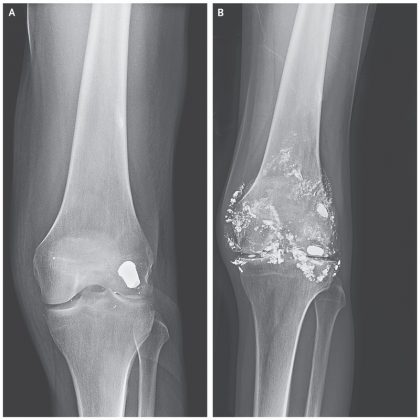- Home
- Editorial
- News
- Practice Guidelines
- Anesthesiology Guidelines
- Cancer Guidelines
- Cardiac Sciences Guidelines
- Critical Care Guidelines
- Dentistry Guidelines
- Dermatology Guidelines
- Diabetes and Endo Guidelines
- Diagnostics Guidelines
- ENT Guidelines
- Featured Practice Guidelines
- Gastroenterology Guidelines
- Geriatrics Guidelines
- Medicine Guidelines
- Nephrology Guidelines
- Neurosciences Guidelines
- Obs and Gynae Guidelines
- Ophthalmology Guidelines
- Orthopaedics Guidelines
- Paediatrics Guidelines
- Psychiatry Guidelines
- Pulmonology Guidelines
- Radiology Guidelines
- Surgery Guidelines
- Urology Guidelines
Case of Knee Arthritis due to embedded bullet for over decade

A rare and unique case appeared in NEJM which showcased lead toxicity from a gunshot wound to the left knee a decade ago.
When a bullet penetrates a person’s body, sometimes it follows a clean path and lands in a harmless place. Data from the CDC warns that bullet fragments left inside of people can have insidious long-term consequences, from fatigue to memory loss to mood disorders to miscarriage.
“Retained bullet fragments (RBFs) are an infrequently reported, but important, a cause of lead toxicity,” the CDC team reports, noting that symptoms “can appear years after suffering a gunshot wound.”
The case described is of a 46-year-old man presented to the emergency department with worsening chronic left knee pain. Fourteen years before presentation, he had sustained a gunshot wound to the left knee. Radiographs obtained at the time of that injury showed a metallic bullet embedded in the posterior weight-bearing surface of the lateral femoral condyle and metallic debris within the joint (Panel A).
No surgery was performed to remove the bullet at that time. At the current presentation, the physical examination was notable for a large effusion in the left knee. Repeat radiographs showed that, in addition to changes consistent with arthritis in the joint, the bullet had fragmented into metallic particles throughout the joint and synovium (Panel B).

Laboratory studies revealed microcytic anaemia, with a haemoglobin level of 9.1 g per deciliter (normal range, 12.9 to 16.8), and an elevated blood lead level (182 μg per deciliter [8.8 μmol per liter]). The Mini-Mental State Examination score was 24 (scores range from 0 to 30, with lower scores indicating poorer cognitive performance). The patient showed no other symptoms of chronic lead poisoning.
Intraarticular bullets should be removed surgically at the time of the injury. In addition to causing joint damage, intraarticular bullets can fragment and dissolve in synovial fluid, leading to lead absorption and delayed symptomatic lead poisoning. The patient received chelation therapy. Surgical management with a left knee synovectomy was planned, but the patient left the hospital before surgery and was lost to follow-up.
CDC advises counselling on the symptoms of lead poisoning and regular testing because a person who was shot a decade ago could become acutely ill if a bit of lead moves into a joint space.
For full information log on to https://www.nejm.org/doi/full/10.1056/NEJMicm1804726

Disclaimer: This site is primarily intended for healthcare professionals. Any content/information on this website does not replace the advice of medical and/or health professionals and should not be construed as medical/diagnostic advice/endorsement or prescription. Use of this site is subject to our terms of use, privacy policy, advertisement policy. © 2020 Minerva Medical Treatment Pvt Ltd